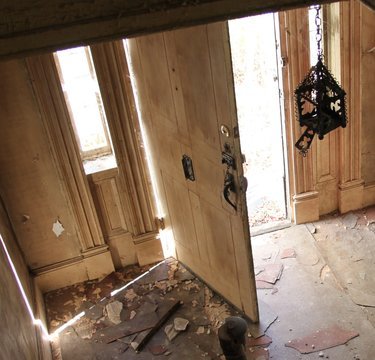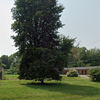The $300,000 third ‘last shot’ to save the Crounse House
ALTAMONT — Billing it as a last-ditch effort to save the Dr. Frederick Crounse House, the citizens’ group Historic Altamont Inc. has asked the house’s owners, the town of Guilderland and village of Altamont, for one last reprieve in order to pursue a grant that may cover the entire cost of restoring the decrepit yet historic home.
The house was built in 1833 by Altamont’s first doctor, Frederick Crounse, who lived and practiced there for six decades. He also helped the Helderberg tenant farmers during the Anti-Rent Wars when they rebelled against the feudal patroon system. During the Civil War, the 134th regiment camped in front of Dr. Crounse’s house as he stayed up all night, helping the regiment doctor with the sick and wounded soldiers.
In 2006, the town and village jointly paid $40,000 in back taxes to Albany County to purchase the historic house and the 2.8 acres on which it stands at the corner of Route 146 and Gun Club Road.
Altamont’s mayor at the time, James Gaughan, described the condition of the building as “fair to good.” He envisioned housing the village’s extensive archives there, where visitors could learn about Altamont’s history. But, instead, neither the town nor village did anything to restore or maintain the structure.
After this story was first posted online on Monday, Trustee Nicholas Fahrenkopf told The Enterprise in an email that “some important context” was needed for why the town and village had done nothing to maintain the Crounse House, pointing to as a contributing factor “the economic collapse in 2008/2009 which meant really hard choices for local governments…”
Choices had become easier in the past few years, as Assemblywoman Patricia Fahy obtained a $175,000 capital project grant for Guilderland; $25,000 of the grant had been designated for the Crounse House roof, but the town spent the money elsewhere.
At the June 4 village-board meeting, Tom Capuano of Historic Altamont said what many were thinking: “I’m sure there’s limited appetite for rehashing some of the proposals that have been furthered [over] the last few months.”
“But,” he continued, “I’d like to try everyone’s patience and ask you to consider one last idea.”
Holding a copy of The Enterprise from January 2004, he read that, even 15 years ago, the house had been described by then-town historian Alice Begley as “sad-looking,” and that, “The new set of stairs that have been built leading to the 150-year-old home look incongruous with the house falling in on itself.”
Capuano then asked, if the house has been “falling in on itself” for 15 years, couldn’t the board wait just a little while longer so that he and group could try to win a Historic Preservation Grant from The New York State Office of Parks, Recreation, and Historic Preservation.
The grant, Capuano told The Enterprise in a follow-up interview, is a matching great, meaning that Historic Altamont has to come up with $150,000 in order to receive $150,000 from the state. Capuano said that there are members of his group who have done professional fundraising and told him that $150,000 was achievable.
“So, all I’m requesting now is that you meet with us so that we can fill out a few more of these details,” Capuano said at the June 4 meeting.
The plan was to knock it down
Mayor Kerry Dineen said that the village had been receiving a lot of emails about the Doctor Crounse House. “We’re getting so many comments,” she said at the June 4 meeting. “That’s why we started looking for … numbers for taking the house down. We are getting so much feedback: ‘Please take the house down.’ We have heard it over and over: ‘Do something; you’ve got to take that house down.’”
Based on those comments, she said, a request for proposal went out to contractors seeking bids to demolish the home. From January to April, Dineen said, the plan had been to knock down the house; however, the town and village hadn’t met since then to discuss the project
Trustee Dean Whalen said that he would entertain Capuano’s idea, but added that, just like in the two previous attempts to save the house, money is the issue. “Because that’s really why it stopped twice before,” Whalen said, it was the lack of funding.
Dineen also said not enough particulars were known. Capuano said that he would provide the board with a letter explaining everything.
“And we’ve been here a few times in the last two years,” Dineen said, “where we’ve extended deadlines just a little more, [because of] a little more interest.”
Trustee Nicholas Fahrenkopf said that the village was “not in a position to [help] financially.” And said that he was skeptical because this “one last shot” is the “third one last shot,” but he maintained that he was open to hearing more details.
Dineen and Fahrenkopf had been told by Guilderland that the town wasn’t interested in owning another historic building.
For sale
Guilderland and Altamont purchased the property, which had sat empty for more than 30 years, from Albany County over a dozen years ago, and did nothing, letting the house fall into disrepair and spending grant money earmarked for a new roof for the Crounse House on other municipal projects.
The town and village planned to demolish the house but, after The Enterprise wrote about the plan and about other municipalities that had sold decaying historic structures so they could be preserved, the local municipalities relented and agreed to see if anyone would buy the Doctor Crounse House.
Little effort was made to promote the sale; the property was not listed with a real-estate agent or even on the town’s website, and brush was not cleared to make the house visible from the road. No buyers were forthcoming.
Historic Altamont was soon formed to pool the collective resources of a group of people who were interested in saving the home.
In July 2018, the village and town had been willing to offer the house to the group for free in exchange for its restoration. The group planned to work with an internationally known timberwright, Jay Cougar White Cloud.
The town and village agreed if White Cloud completed the specified restoration work within two years, the municipalities would subdivide a 1.8-acre lot behind the Crounse House where White Cloud would build his own house to live in. The town and village would continue to jointly own the remaining 1-acre parcel with the Crounse House on it.
Historic Altamont envisioned opening the restored Doctor Crounse House to the public and using it as a teaching tool for historic restoration. The group cleared brush from the property and, in August 2018, set about covering the roof to protect the structure from the season’s relentless rains. White Cloud was spotted on the roof, and the town was alerted; officials said group members could not be on the roof.
Capuano started applying for a building permit so that he could get up on the roof himself but the town would not accept his own homeowner’s insurance, he said.
“I guess it didn’t satisfy their liability requirements. That was a big disappointment,” he said earlier. “What it boiled down to was whoever was going to do this work had to have contractors’ liability insurance.” No one in Historic Altamont had that. None of them were doing this work as a livelihood.
John Grennon, a builder who specializes in historic restoration, had also expressed interest in the Doctor Crounse House. His plan was to restore the home and sell it; however, for Grennon, like Capuano and Historic Altamont, the issue was cost.
“Believe it or not, there’s $50,000 worth of asbestos removal,” Grennon told The Enterprise. It would have taken $250,000 — which didn’t include Grennon paying himself — for him to restore the house, he said, adding that the project would have taken a year to complete.
At the June 4 village-board meeting, one of the justifications given for the village not getting involved with the project was that the roof alone would have been a six-figure fix. Grennon, however, said that it could have been done for $10,000, adding, “So, even if I don’t know what I’m talking about, you’re at $20,000.”
But when municipalities are footing the bill, he said, some contractors will say, “Let’s slam ’em” on the price.
“Basically, you need to take the house apart and put it back together,” Grennon said. “It can be done, it’s not that large of a home.”
Historic Altamont told the village and town that its application would request funding for asbestos remediation; structural work like the roof and foundation; fire suppression; heating, ventilation, and air-conditioning; an exhibit space; signage; and site improvements.
The grant
The Historic Preservation Grant from The New York State Office of Parks, Recreation, and Historic Preservation is used, according to the office itself, “to improve, protect, preserve, rehabilitate, restore, or acquire properties listed on the State or National Registers of Historic Places and for structural assessments and/or planning for such projects.”
Over the past three years, according to the state parks office, there have been between 97 and 123 applicants for a Historic Preservation Grant. Over the same period between 20 percent and 24 percent of grant applications were approved.
In 2018, $6.8 million in grants were doled out to 25 projects.
Potential projects are rated on seven criteria:
— How much physical deterioration, decay, vandalism, and neglect the project has suffered;
— The relationship of the project to a planning document or other assessment of need;
— How much the project would enhance or interpret historic resources;
— That the project can be done on time and at cost, and how the completed project will be maintained;
— The historical significance of the property;
— How much the project will increase the public’s awareness of historic resources; and
— How the project will be funded annually.
In addition, each year, the parks commissioner “establishes program priorities for which projects will receive additional points,” meaning that each year, the commissioner can give preference to one type of preservation project over another.
In a letter to the town of Guilderland and village of Altamont, Historic Altamont told the municipalities that it thinks the Crounse House would qualify for a grant based on criteria one, two, five, and that the “project relates or contributes to documented plans ... such as Preserve America designation, Path Through History … The present integration of the Crounse property with the ‘Museum in the Streets’ will meet this criterion.”
Capuano said that he is “hopeful” that Historic Altamont’s grant application will be considered by the state, but he said that there is “very stiff competition.”
As for the group’s actual chances of winning a grant, Historic Altamont, in its letter to the village and town, pointed to five similar restoration projects that were awarded between $300,000 and $500,000 in the past three years:
— $250,000 for the rehabilitation of 44 Central Ave. in Albany County;
— $500,000 to rehabilitate the Trudeau Building in Franklin County;
— $168,525 for the preservation of the Aurora Masonic Center;
— $262,495 to restore the Jay Gould Memorial Church in Delaware County; and
— $487,500 for phase III of the restoration of the Dr. Oliver Bronson House.
In its letter, the group also noted that the Altamont Free Library received a similar grant of $112,000 for the renovation of its building.
But before any of this can even start, Capuano needs the town and village to say they are willing to wait for the grant process to play out, which could take about six months.
Capuano told the village and town that his group needs to know if they approve by June 12, “because the application process is so demanding,” Historic Altamont said in a letter to both the town and village.
Guilderland, Capuano said, “seems to be open” to the proposal.
Peter Barber, Guilderland’s supervisor, told The Enterprise that the town is open to the proposal. “I have met with Tom and his group a number of times and let Tom know that, yes, obviously, if he’s got a grant that Historic Altamont Inc. might be applying for, then the town would be supportive of that,” Barber said.
Altamont, however, may be a little more reticent because villagers have to look at the decaying house every day, and, for that reason, he said, the village trustees are probably more sensitive to complaints about the appearance of the house.
But Capuano is also encouraged because the village board at least agreed to read the letter he’s written explaining the grant his group is trying to obtain.
“All we can hope for is that they will keep an open mind,” he said.




So what if people are agitated when they look at a deteriorating historic house? Do signs on the property across the road bother them? They are ugly. Does the vast wasteland that was Ron's Service Station bother them, too? Folks, if you don't like to look at it, that's what eyelids are for. And the fire scene on Prospect Terrace, that's really ugly. If you don't have any appreciation for American history, why are you living here?
Altamont is attracting intolerant prople who want a picture-book community, where buildings don't age, dogs don't pee and poop, where kids make noise when they play, where they can put up a fence to keep undesirables out, and soon they'll be after old people like me because I cross the street slowly.
I posted this on the Altamont Community FB page: The real issue is whether the Altamont community would support rehabilitation of this 'sad old house' to become a Welcome/Community Center for Altamont and the hilltowns (could be such an amazing cultural resource). If Historic Altamont goes for the grant (at no cost to the Town or Village) would the community be willing to wait - and support fundraising efforts? It's easy to tear down a historic property but what if it could be saved and made into a welcome center/museum/community center? It would take an incredible push to make it happen but Altamont has taken on challenges like this (the library, the elementary school) and succeeded. The 'bones' of the main house have been looked at by preservation architects. The main house can be saved. The back end should be demolished. Wouldn't it be amazing if when you got to the corner of Gun Club and 146 there was a welcome center/museum with a beautiful garden and almost 2 acres behind it for a community garden or trails for families or maybe a dog park? Wouldn't that be a better vision than just demolishing a property with a history dating back beyond the Civil War? It is the gateway to Altamont and the Hilltowns. It is the trailhead to the Museum in the Streets that I think we are all very proud of. Would the community prefer a couple of new homes on the site or an empty lot?